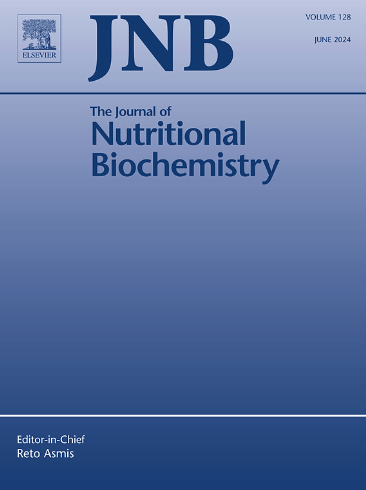Ursolic acid attenuates sarcopenia through IL-17a-related gut-muscle axis in senile diabetic mice and myotube model
IF 4.8
2区 医学
Q1 BIOCHEMISTRY & MOLECULAR BIOLOGY
引用次数: 0
Abstract
Sarcopenia significantly impairs quality of life, especially in diabetic patients, where effective treatment options remain limited. The IL-17a-related gut-muscle axis suggests a potential role of the gut microbiota in the development of sarcopenia. Ursolic acid (UA) has shown promise as an anti-sarcopenic agent. Nevertheless, the relationship between UA and the IL-17a-related gut-muscle axis remains unclear. In this research, sarcopenia model was established using streptozotocin in vivo and in vitro with TNF-α-managed C2C12 myotubes. UA significantly altered the gut microbiota, notably increasing observed OTUs and the Shannon index of sarcopenic mice. Specifically, UA effectively mitigated the decrease of Bacteroides thetaiotaomicron and restored the total level of short-chain fatty acids, particularly reducing propionic acid and increasing isovaleric acid. Additionally, UA markedly improved muscle quality and function, as evidenced by increased body weight, grip strength, and muscle weight, as well as significantly decreased expression of Atrogin-1 and MuRF-1. Moreover, RNA sequencing results clearly indicated that UA suppressed the IL-17 signaling pathway in sarcopenic mice. Furthermore, UA alleviated oxidative stress and apoptosis in sarcopenic mice. Notably, UA inhibited the IL-17a pathway in sarcopenic mice by suppressing the heightened expression of the proteins. In vitro experiments further confirmed that UA inhibited TNF-α-induced myotube atrophy, reduced Atrogin-1 and MuRF-1 expression, and strongly suggested that IL-17a may be a key target of UA in combating myotube atrophy. The study emphasizes the importance of UA in alleviating sarcopenia, possibly through the IL-17a-related gut-muscle axis.
熊果酸通过il -17a相关肠肌轴减轻老年糖尿病小鼠和肌管模型中的肌肉减少症。
背景:骨骼肌减少症显著损害生活质量,特别是糖尿病患者,其有效治疗选择仍然有限。il -17a相关的肠肌轴提示肠道微生物群在肌少症发展中的潜在作用。熊果酸(UA)已显示出作为一种抗肌减少剂的前景。然而,UA与il -17a相关的肠肌轴之间的关系尚不清楚。方法:采用TNF-α-管理的C2C12肌管,采用链脲佐菌素建立体内外肌少症模型。结果:UA显著改变了肠道菌群,显著增加了肌肉减少小鼠的OTUs和Shannon指数。具体来说,UA有效地减缓了拟杆菌的减少,恢复了短链脂肪酸的总水平,特别是减少了丙酸和增加了异戊酸。此外,UA显著改善了肌肉质量和功能,如体重、握力和肌肉重量的增加,以及Atrogin-1和MuRF-1的表达显著降低。此外,RNA测序结果清楚地表明,UA抑制了肌少症小鼠的IL-17信号通路。此外,UA还能减轻肌肉减少小鼠的氧化应激和细胞凋亡。值得注意的是,UA通过抑制IL-17a蛋白的表达来抑制肌肉减少小鼠的IL-17a通路。体外实验进一步证实了UA可抑制TNF-α-诱导的肌管萎缩,降低Atrogin-1和MuRF-1的表达,强烈提示IL-17a可能是UA抗肌管萎缩的关键靶点。结论:该研究强调了UA在缓解肌肉减少症中的重要性,可能通过il -17a相关的肠肌轴。
本文章由计算机程序翻译,如有差异,请以英文原文为准。
求助全文
约1分钟内获得全文
求助全文
来源期刊

Journal of Nutritional Biochemistry
医学-生化与分子生物学
CiteScore
9.50
自引率
3.60%
发文量
237
审稿时长
68 days
期刊介绍:
Devoted to advancements in nutritional sciences, The Journal of Nutritional Biochemistry presents experimental nutrition research as it relates to: biochemistry, molecular biology, toxicology, or physiology.
Rigorous reviews by an international editorial board of distinguished scientists ensure publication of the most current and key research being conducted in nutrition at the cellular, animal and human level. In addition to its monthly features of critical reviews and research articles, The Journal of Nutritional Biochemistry also periodically publishes emerging issues, experimental methods, and other types of articles.
 求助内容:
求助内容: 应助结果提醒方式:
应助结果提醒方式:


